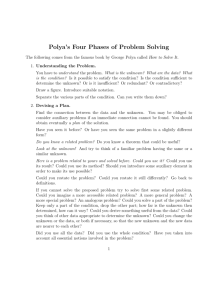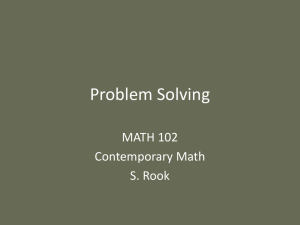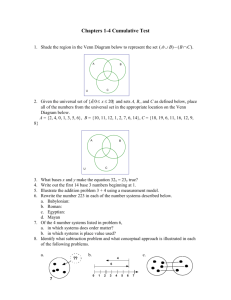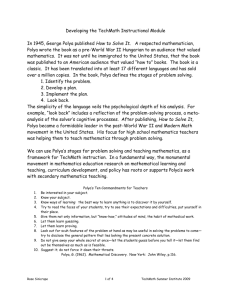Document 10908883
advertisement
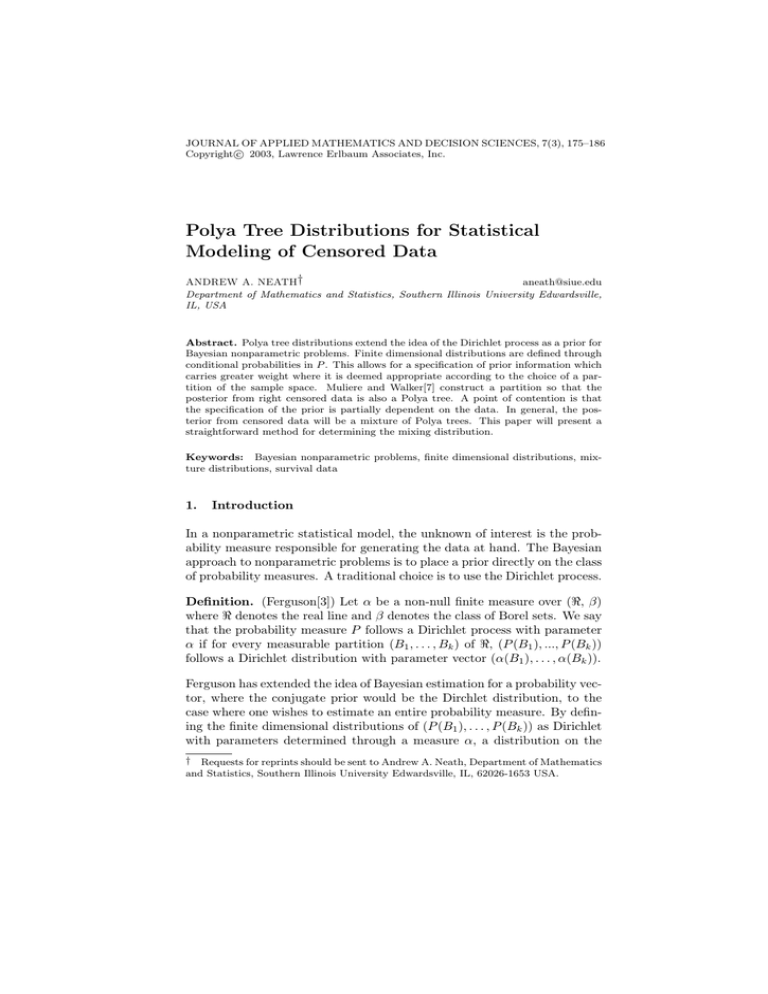
JOURNAL OF APPLIED MATHEMATICS AND DECISION SCIENCES, 7(3), 175–186
c 2003, Lawrence Erlbaum Associates, Inc.
Copyright
Polya Tree Distributions for Statistical
Modeling of Censored Data
ANDREW A. NEATH†
aneath@siue.edu
Department of Mathematics and Statistics, Southern Illinois University Edwardsville,
IL, USA
Abstract. Polya tree distributions extend the idea of the Dirichlet process as a prior for
Bayesian nonparametric problems. Finite dimensional distributions are defined through
conditional probabilities in P . This allows for a specification of prior information which
carries greater weight where it is deemed appropriate according to the choice of a partition of the sample space. Muliere and Walker[7] construct a partition so that the
posterior from right censored data is also a Polya tree. A point of contention is that
the specification of the prior is partially dependent on the data. In general, the posterior from censored data will be a mixture of Polya trees. This paper will present a
straightforward method for determining the mixing distribution.
Keywords: Bayesian nonparametric problems, finite dimensional distributions, mixture distributions, survival data
1.
Introduction
In a nonparametric statistical model, the unknown of interest is the probability measure responsible for generating the data at hand. The Bayesian
approach to nonparametric problems is to place a prior directly on the class
of probability measures. A traditional choice is to use the Dirichlet process.
Definition. (Ferguson[3]) Let α be a non-null finite measure over (<, β)
where < denotes the real line and β denotes the class of Borel sets. We say
that the probability measure P follows a Dirichlet process with parameter
α if for every measurable partition (B1 , . . . , Bk ) of <, (P (B1 ), ..., P (Bk ))
follows a Dirichlet distribution with parameter vector (α(B1 ), . . . , α(Bk )).
Ferguson has extended the idea of Bayesian estimation for a probability vector, where the conjugate prior would be the Dirchlet distribution, to the
case where one wishes to estimate an entire probability measure. By defining the finite dimensional distributions of (P (B1 ), . . . , P (Bk )) as Dirichlet
with parameters determined through a measure α, a distribution on the
† Requests for reprints should be sent to Andrew A. Neath, Department of Mathematics
and Statistics, Southern Illinois University Edwardsville, IL, 62026-1653 USA.
176
A. NEATH
probability P is implied. The weight of the prior information is the constant α(<).
Polya tree distributions ([5], [6]) extend the idea of the Dirichlet process
by defining the finite dimensional distributions as conditional probabilities
in P . This allows for a specification of prior information which carries
greater weight in subsets of < where it is deemed appropriate according to
the choice of a partition of <.
In this paper, we present an analysis based on nonparametric Bayesian
methods when the prior is a Polya tree and the available data is subject
to censoring. Section 2 contains the needed mathematical background on
Polya tree distributions. Muliere and Walker[7] (subsequently referred to
as MW) examine Polya tree priors in survival analysis, constructing a partition so the posterior from right censored data will also be from the family
of Polya tree distributions. A point of contention is that the specification
of the prior is partially dependent on the data. Without this construction, the posterior from censored data will be a mixture of Polya trees.
We will present in Section 3 a straightforward method for determining this
mixing distribution. Our concluding section contains an example as well
as a discussion on how the choice of a partition influences the posterior
estimate.
2.
Polya Tree Distributions
The necessary partitioning of the sample space for defining a Polya tree is
done is stages. Actually, we refer to a sequence of ever finer partitions.
Let {B0 , B1 } be a measurable partition of <. Then let {B00 , B01 } be a
measurable partition of B0 and {B10 , B11 } be a measurable partition of
B1 . We continue in this manner. Let E m = { = 1 · · · m : k ∈ {0, 1}},
m
th
m = 1, 2, . . . with E 0 = {∅}. Let E ? = ∪∞
stage, B for
m=0 E . At the m
m
∈ E is partitioned into {B0 , B1 }. We allow for the possible split of
B0 = ∅, B1 = B . We require that Π = {B0 , B1 , B00 , B01 , . . .} generates
the Borel sets.
Now define a sequence of random variables Y = {Y0 , Y00 , Y10 , . . .}, and a
sequence of nonnegative real-valued parameters A = {α0 , α1 , α00 , α01 , . . .},
with Y0 ∼ Beta (α0, α1 ) for ∈ E ? . The subscripts ∅0 and ∅1 are interpreted as 0 and 1, respectively. The random variables in Y determine
conditional probabilities in P as Y0 = P (B0 | B ).
The particular Polya tree distribution is determined by the partitions in
Π and the Beta parameters in A.
177
POLYA TREE MODELING OF CENSORED DATA
Definition. (Lavine[5]) The random probability measure P on < is said to
have a Polya tree distribution with parameter (Π, A) if there exists random
variables Y = {Y0 , Y00 , Y10 , . . .} such that the following hold:
(i) the random variables in Y are independent;
(ii) for every ∈ E ? , Y0 ∼ Beta (α0 , α1 );
(iii) for every m = 1, 2, . . ., and every ∈ E m ,
m
m
Y
Y
P (B ) =
Y1 ...j−1 0
1 − Y1 ...j−1 0 .
j=1
j = 1
{j = 0}
{j = 1}
We will use the notation P ∼PT(Π, A). The weight of the information on P (B0 B ) is given by α0 + α1 . Polya
trees are generalizations of Dirchlet processes. A Polya tree is a Dirichlet
process if for every ∈ E ? , α = α0 + α1 ([5]). Without this restriction,
one has the option of choosing α0 + α1 large to reflect greater weight or
small to reflect greater uncertainty as to the nature of the true probability
P on the set B .
The choice of a partition plays no role in defining a Dirichlet process, so
long as the above restriction is met. We shall see that the choice of the
sets B , ∈ E ? , in the partition can play an important role in specifying a
Polya tree prior.
Random variables W1 , . . ., Wn are said to be a sample of size n from P
if
W1 , . . . , Wn P ∼ iid P for P ∼ P T (Π, A) .
The unconditional distribution of an observation Wi is given for ∈ E ? as
P[Wi ∈ B ] = E P[Wi ∈ B P ]
= E[P (B )]
= E[P (B1 )P (B1 2 B1 ) . . . P (B B1 ...m−1 )]
α1 ...m
α1
···
.
=
α0 + α1
α1 ...m−1 0 + α1 ...m−1 1
We can think of this expression as a prior estimate P̂0 (B ) of P (B ).
178
A. NEATH
The posterior distribution is obtained ([5]) as
P {Wi } ∼ P T (Π,A (W1 , . . . , Wn ))
where
α (W1 , . . . , Wn ) = α + n and n = # {Wi ∈ B } .
(1)
A complete observation W increases by 1 all parameters corresponding to
sets for which W ⊆ B .
A posterior estimate of the probability measure evaluated at B , ∈ E m ,
is
P̂ (B ) = E [P (B ) | W1 , . . . , Wn ]
α1 + n1
α1 ...m + n1 ...m
...
.
=
α0 + α1 + n
α1 ...m−1 0 + α1 ...m−1 1 + n1 ...m−1
(2)
Our interest is in using Polya tree distributions for modeling problems
with censored data. We look to how the posterior is computed from an
observation W known only to be contained in some set A. If A ∈ Π, then
the posterior will still be a Polya tree distribution. The updated sequence
of parameters is defined through
α + 1, if A ⊆ B
α (A) =
.
(3)
α , otherwise
Result (3) will be demonstrated by a small example. Let m = 2 and
consider sets B0 , B1 and B00 , B01 , B10 , B11 . Suppose the Polya tree is
parametrized by α0 = 1, α1 = 3 and α00 = 1, α01 = 1, α10 = 3, α11 = 1.
The prior estimate of P (B0 ) is 14 and the prior estimates of P (B00 |B0 ) and
P (B10 |B1 ) are 21 and 34 , respectively. Thus, the probability vector [P (B00 ),
P (B01 ), P (B10 ), P (B11 )] is estimated a priori as
1 1 1 1 3 3 3 1
[( )( ), ( )( ), ( )( ), ( )( )]
4 2 4 2 4 4 4 4
=
[.125, .125, .5625, .1875].
Suppose we observe two censored observations described as [W1 ∈ A1 ],
[W2 ∈ A2 ] with A1 = B01 , A2 = B10 ∪B11 = B1 . Since A1 ⊆ B01 ⊆ B0 , the
updated parameters become α01 = 2, α0 = 2, and the updated probability
vector estimate becomes
2 1 2 2 3 3 3 1
[( )( ), ( )( ), ( )( ), ( )( )]
5 3 5 3 5 4 5 4
=
[.133, .267, .45, .15].
Note the estimate of P (B00 ) has increased even though it is known W1 ∈
/
B00 . This is a consequence of the partitioning, which reflects a belief that an
POLYA TREE MODELING OF CENSORED DATA
179
observation in B01 signals a greater likelihood for event B00 than for events
B10 and B11 . For the second observation, A2 ⊆ B1 . The only updated
parameter is α1 = 4. Since no further information is available from this
observation, the parameters within the second partition are unchanged.
We now have
[P̂ (B00 ), P̂ (B01 ), P̂ (B10 ), P̂ (B11 )]
2 1 2 2 4 3 4 1
= [( )( ), ( )( ), ( )( ), ( )( )] = [.111, .222, .5, .167].
6 3 6 3 6 4 6 4
MW[7] show how Polya tree priors update from right censored data provided the partitions are constructed with respect to the censoring times.
We take up the problem of determining the posterior in a setting which is
slightly broader.
3.
Mixtures Of Polya Tree Distributions
We begin with the following result for a single censored observation.
Theorem 1 Suppose P ∼ P T (Π, A). Let W be a sample from P and
suppose that our information consists of W ∈ A. Then,
P ξ, W ∈ A ∼ P T (Π, A(ξ)) where ξ =d W W ∈ A.
We discuss Theorem 1 before presenting a formal proof. Bayesian updating is accomplished after a censored observation by introducing the variable
ξ to represent the unobserved realization W from P . To better understand
a mixture of Polya trees, we examine our result written as
P ξ ∼ P T (Π, A(ξ)) , ξ ∼ H.
(4)
Consider the finite-dimensional distributions defined through the random
variables in
m
Y M = Yγ0 : γ ∈ E?M where E?M = ∪M
m=0 E .
Then
Y
P Yγ0 ≤ sγ0 , ∀γ ∈ E?M ξ =
β sγ0 αγ0 (ξ) , αγ1 (ξ)
γ∈E?M
(5)
180
A. NEATH
where β ·a, b denotes the cumulative distribution function for Beta(a, b).
So,
P Yγ0 ≤ sγ0 , ∀γ ∈ E?M
(6)
Z Y
=
β sγ0 αγ0 (ξ) , αγ1 (ξ) dH (ξ) .
γ∈E?M
Note that β sγ0 αγ0 (ξ) , αγ1 (ξ) is constant in ξ over B , for each ∈
E M +1 . Thus,
P Yγ0 ≤ sγ0 , ∀γ ∈ E?M
X
Y
=
P (ξ ∈ B )
β sγ0 αγ0 (B ) , αγ1 (B )
M +1
M
∈E
(7)
γ∈E?
where for i = 0, 1
αγ i (B ) =
αγ i + 1, if B ⊆ Bγ i
.
αγ i , otherwise
The induced posterior on Y M is a weighted average of product-Beta distributions, with the weights determined by probabilities on the index variable ξ.
Proof:
We look to determine the induced posterior on Y M , with M arbitrary:
P Yγ0 ≤ sγ0 , ∀γ ∈ E?M W ∈ A
For ∈ E M +1 ,
Y
β sγ0 αγ0 (B ) , αγ1 (B )
γ∈E?M
= P Yγ0 ≤ sγ0 , ∀γ ∈ E?M W ∈ B
= P Yγ0 ≤ sγ0 , ∀γ ∈ E?M W ∈ B ,W ∈ A
when the event [W ∈ B ,W ∈ A] is nonempty. Then,
Y
P [W ∈ B |W ∈ A] ×
β sγ0 αγ0 (B ) , αγ1 (B )
γ∈E?M
= P Yγ0 ≤ sγ0 , ∀γ ∈ E?M ,W ∈ B W ∈ A .
181
POLYA TREE MODELING OF CENSORED DATA
th
Summing over the (M + 1) partition, we obtain
X
Y
P [W ∈ B |W ∈ A] ×
β sγ0 αγ0 (B ) , αγ1 (B )
∈E M +1
γ∈E?M
(8)
= P Yγ0 ≤ sγ0 , ∀γ ∈ E?M W ∈ A .
The proof is done since this is the same form as (7) with ξ =d W W ∈ A.k
Now consider a sample of censored observations. An updating scheme
will be developed through induction. Let ξn denote the random vector
representing the unobserved W1 , . . . , Wn . Then the distribution on P prior
to the (n + 1)th censored observation can be described by the mixture of
Polya trees in (4). A direct application of Theorem 1 yields the posterior
given [Wn+1 ∈ An+1 ] as
P |ξn , ξn+1 ∼ P T (Π, A (ξn , ξn+1 )) with ξn+1 ξn =d W W ∈ An+1 , ξn
and
P Wn+1 ∈ An+1 ξn dH (ξn )
dH ξn Wn+1 ∈ An+1 = R
.
P Wn+1 ∈ An+1 ξn dH (ξn )
(9)
Note the distribution of ξn is changed through the updating procedure.
This prevents a stochastic process depiction of the mixing distribution, a
technique which has been utilized in similar problems ([1],[2], [8]).
We continue with our example to show the use of result (9). After the first
two observations, the Polya tree has parameters α0 = 2, α1 = 4, α00 = 1,
α01 = 2, α10 = 3, α11 = 1, and the current estimate of the probability
vector is
1 2 1 1
[P̂ (B00 ), P̂ (B01 ), P̂ (B10 ), P̂ (B11 )] = [ , , , ].
9 9 2 6
Recall that this also represents the unconditional distribution for the next
observation.
Suppose the next two censored observations are given as [W3 ∈ A3 ],
[W4 ∈ A4 ] with A3 = B01 ∪ B10 , A4 = B00 ∪ B01 . Since A3 is not a set in
Π, the posterior will become a mixture of Polya trees.
The mixing variable ξ3 will initially have probabilities
P(ξ3 ∈ B01 ) = P(W3 ∈ B01 W3 ∈ A) =
and
2
9
2
9
+
1
2
=
4
13
182
A. NEATH
9
P(ξ3 ∈ B10 ) = P(W3 ∈ B10 W3 ∈ A) =
.
13
If ξ3 ∈ B01 , then α0 and α01 increase by 1. Likewise for α1 and α10 if
ξ3 ∈ B10 . The newly updated estimate is given as a weighted average:
4
3 1 3 3 4 3 4 1
)[( )( ), ( )( ), ( )( ), ( )( )]
13 7 4 7 4 7 4 7 4
9
2 1 2 2 5 4 5 1
+( )[( )( ), ( )( ), ( )( ), ( )( )]
13 7 3 7 3 7 5 7 5
= [.099, .231, .527, .143].
(
Now after observing [W4 ∈ A4 ], we must adjust the probabilities on the
variable ξ3 according to (9). So,
P(ξ3 ∈ B01 ) P(W4 ∈ A4 ξ3 ∈ B01 )
P(ξ3 ∈ B01 W4 ∈ A4 ) =
P(W4 ∈ A4 )
4
( 13
)( 12
2
28 )
=
= 4 12
9
6
5
( 13 )( 28 ) + ( 13 )( 21 )
since
P(W4 ∈ A4 ) = P(ξ3 ∈ B01 )P(W4 ∈ A4 ξ3 ∈ B01 )
+P(ξ3 ∈ B10 )P(W4 ∈ A4 ξ3 ∈ B10 ).
The denominator may also be computed from the current estimate of the
probability vector.
We see the probability on event [W3 ∈ B01 ] has increased after observing
[W4 ∈ B00 ∪ B01 ]. The mathematics follows the logic which says an
observation at B01 increases the likelihood of that event.
Conditional on ξ3 , one can calculate the probabilities on ξ4 to be
P[ξ4 ∈ B00 ξ3 ∈ B01 ] = 1/4 and P[ξ4 ∈ B00 ξ3 ∈ B10 ] = 1/3.
Then
P[ξ4 ∈ B01 ξ3 ∈ B01 ] = 3/4 and P[ξ4 ∈ B01 ξ3 ∈ B10 ] = 2/3.
The mixing distribution on the variables (ξ3 , ξ4 ) has probabilities
P[ξ3
P[ξ3
P[ξ3
P[ξ3
∈ B01 , ξ4
∈ B01 , ξ4
∈ B10 , ξ4
∈ B10 , ξ4
∈ B00 ]
∈ B01 ]
∈ B00 ]
∈ B01 ]
=
=
=
=
(2/5)(1/4) = .1,
(2/5)(3/4) = .3,
(3/5)(1/3) = .2,
(3/5)(2/3) = .4.
POLYA TREE MODELING OF CENSORED DATA
183
In this manner, we can determine the mixing distribution for any number
of censored observations.
For our example, the observed sets could be written by finite unions of
sets in Π. This condition does not impose a significant restriction. As
the sample space is partitioned into smaller sets, the observed sets will
become closely approximated by sets in Π at some level M . This is similar
motivation to that of sampling an approximate probability measure from
a Polya tree distribution by terminating the procedure at a finite level.
4.
An Application
We use the data given in Kaplan and Meier[4] and analyzed by MW[7].
deaths occurred at
censoring times at
0.8 3.1 5.4 9.2
1.0 2.7 7.0 12.1
The partition defined by MW so that the posterior on the survival distribution will also be a Polya tree is given in Table 1. We consider a partition
based upon breaking the interval [0, ∞) into subintervals of equal length
as is seen in Table 2.
Table 1. Muliere, Walker partition
m=1:
m=2:
m=3:
m=4:
m=5:
m=6:
B0 = (0, 1.0], B1 = (1.0, ∞)
B00 = (0, 0.8], B01 = (0.8, 1.0], B10 = (1.0, 2.7], B11 = (2.7, ∞)
B110 = (2.7, 7.0], B111 = (7.0, ∞)
B1100 = (2.7, 3.1], B1101 = (3.1, 7.0], B1110 = (7.0, 12.1],
B1111 = (12.1, ∞)
B11010 = (3.1, 5.4], B11011 = (5.4, 7.0], B11100 = (7.0, 9.2],
B11101 = (9.2, 12.1]
B110110 = (5.4, 6.0], B110111 = (6.0, 7.0]
Polya tree modeling allows for the prior to be centered on a particular
distribution P0 according to the choice of the parameters in A. For ∈ Em ,
let α = γm P0 (B ) where γm > 0. We determine the parameters for our
Polya tree prior by letting P0 correspond to the exponential distribution
with failure rate λ = 0.12. The prior estimate of the survival function
becomes
Ŝ0 (t) = exp {−0.12 t} .
184
A. NEATH
Table 2. An alternate partition
B0 = (0, 8], B1 = (8, ∞)
B00 = (0, 4], B01 = (4, 8], B10 = (8, 12], B11 = (12, ∞)
B000 = (0, 2], B001 = (2, 4], B010 = (4, 6], B011 = (6, 8]
B100 = (8, 10], B101 = (10, 12], B110 = (12, 14], B111 = (14, ∞)
The partition follows this pattern as m gets larger.
m=1:
m=2:
m=3:
Also, we take γm = m2 . This choice is sufficient for the Polya tree prior to
place probability 1 on distributions which are absolutely continuous.
Aside from differences in the partition Π, our prior is equivalent to the one
considered by MW. The posterior estimates of survival can be compared
using Tables 3 and 4. Here, we can see the effect of Π as our estimates of
survival are larger than those from MW.
We will take the set (0, 1.0] as a basis of comparison. In the MW partition,
this set is B0 . For the alternate partition, the set (0, 1.0] is an element of
Π for m = 4, rather than m = 1.
An observed death represents a complete realization and updates the
distribution on P according to (1). There are four complete observations
in our data set. For the MW partition, this results in
α0MW → α0MW + 1, α1MW → α1MW + 3.
The alternate partition after the four deaths are incorporated gives
α0 → α0 + 3, α1 → α1 + 1
α00 → α00 + 2, α01 → α01 + 1
α000 → α000 + 1, α001 → α001 + 1
α0000 → α0000 + 1.
At this point, the estimates of S(1.0), which were equal a priori, are
MW: S(1.0) =
alt: S(1.0) =
=
=
1 − P (B0MW ) = .6855
1 − P (B0000 )
1 − P (B0 )P (B00 |B0 )P (B000 |B00 )P (B0000 |B000 )
.867.
An observation known to be in a set B for ∈ E m will have a greater
impact on the probability estimate P̂ (B ) when m is small. Lavine[5] states
185
POLYA TREE MODELING OF CENSORED DATA
Table 3. Survival estimates based upon the MW partition
prior:
posterior:
t
Ŝ0 (t)
ŜM W (t)
0.8
.908
.884
1.0
.887
.877
2.7
.723
.818
3.1
.689
.745
prior:
posterior:
t
Ŝ0 (t)
ŜM W (t)
6.0
.487
.538
7.0
.432
.492
9.2
.332
358
12.1
.234
.263
5.4
.523
.568
Table 4. Survival estimates based upon an equal length interval partition
prior:
posterior:
t
Ŝ0 (t)
ŜM W (t)
1.0
.887
.902
2.0
.787
.843
3.0
.698
.788
4.0
.619
.695
5.0
.549
.647
6.0
.487
.561
prior:
posterior:
t
Ŝ0 (t)
ŜM W (t)
8.0
.383
.499
9.0
.340
.448
10.0
.301
.331
11.0
.267
.301
12.0
.237
.275
13.0
.210
.244
7.0
.432
.530
“choosing α for small m typically involves judgments about sets which
have large initial probability. For large m, the consideration is that α can
express a belief about the smoothness of P .” An indication of this effect is
seen here with the observed death at 0.8 having large influence under the
MW partition.
The four censored observations are considered next. The MW partition,
by design, keeps the posterior within the Polya tree family. The alternate
partition gives a mixture of Polya trees for its posterior and thus is not
represented as nicely mathematically. It was chosen, however, to reflect
true prior uncertainty, not for mathematical tractability.
Acknowledgments
The author wishes to thank an anonymous referee whose input has led to
a much improved version of this manuscript.
186
A. NEATH
References
1. P. K. Bhattacharya. Posterior distribution of a Dirichlet process from quantal
response data. Annals of Statistics, 9, 803-811, 1981.
2. J. Blum and V. Susarla. On the posterior distribution of a Dirichlet process given
randomly right censored observation. Stochastic Processes and Their Application,
5, 207-211, 1977.
3. T. S. Ferguson. A Bayesian analysis of some nonparametric problems. Annals of
Statistics, 1, 209-230, 1973.
4. E. L. Kaplan and P. Meier. Nonparametric estimation from incomplete observations. Journal of American Statistical Association, 53, 457-481, 1958.
5. M. Lavine. Some aspects of Polya tree distributions for statistical modelling. Annals
of Statistics, 20, 1222-1235, 1992.
6. R. D. Mauldin, W. D. Sudderth and S. C. Williams. Polya trees and random
distributions. Annals of Statistics, 20, 1203-1221, 1992.
7. P. Muliere and S. Walker. A Bayesian nonparametric approach to survival analysis
using Polya trees. Scandinavian Journal of Statistics, 24, 331-340, 1997.
8. A. A. Neath and F. J. Samaniego. On Bayesian estimation of the multiple decrement function in the competing risks problem. Statistics and Probability Letters,
31, 75-85, 1996.
